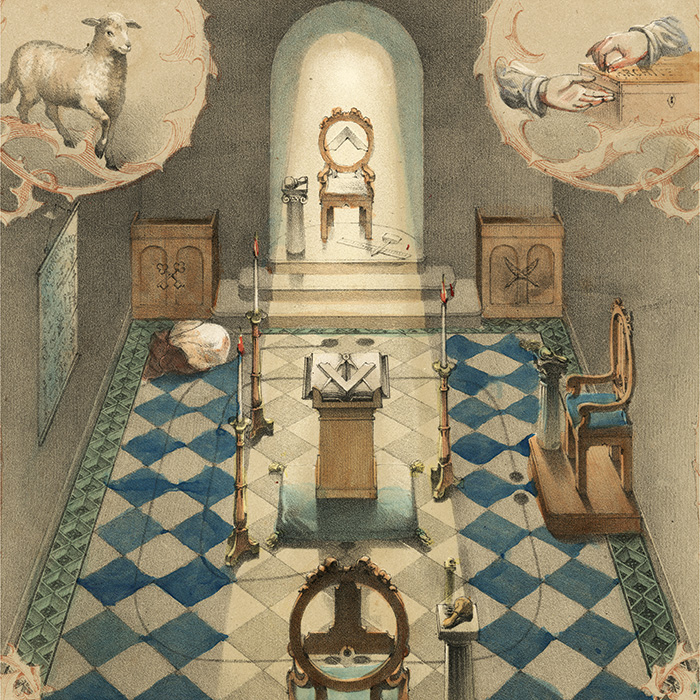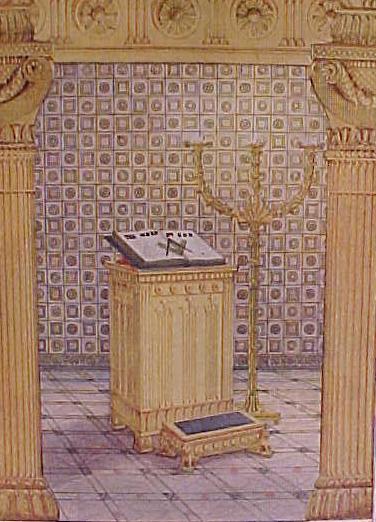Masonic Articles and Essays
Circumambulation in a Masonic Lodge
Unknown
Date Published:
5/1/2022
Circumambulation is one of the oldest and most integral parts of Masonic Ritual. What is the origin and meaning of this universal practice?
 Masonic circumambulation of the alter is one of the oldest ceremonies of Freemasonry. The ritualistic explanation is simple enough and of course the act does permit continued and lengthy inspection of the candidate by the brethren. But this explanation was obviously made to fit into the lodge and was composed by men who had lost the authentic knowledge of the real meaning of the ceremony of circling the alter so that now few brethren are convinced that the simple ritualistic explanation conveys all the truth.
Masonic circumambulation of the alter is one of the oldest ceremonies of Freemasonry. The ritualistic explanation is simple enough and of course the act does permit continued and lengthy inspection of the candidate by the brethren. But this explanation was obviously made to fit into the lodge and was composed by men who had lost the authentic knowledge of the real meaning of the ceremony of circling the alter so that now few brethren are convinced that the simple ritualistic explanation conveys all the truth.
Vedic Circumambulation, from India, is a religious practice consisting of walking around a sacred place as a sign of veneration and piety. Vedic Circumambulation or "Walking the Way" is a form of deep veneration with origins dating to ancient India, where to circumambulate three times was a means of honoring a greatly respected person.
In Pradakshina (Jainist Circumambulation), we keep the holy object(s) always on our right side. Therefore, we circumambulate (go around) the holy place three times keeping it on our right side, that is walking around from our left to the right. While going around, we remind ourselves that holy things are precious, that they are our guide, and that one day we will be more worthy of the refinements they offer to us. This contemplation of the holy place (alter), or holy object, will help us overcome our attachment to material things, concern with outward appearances, and achieve brotherly love (overcome hatred). Three circumambulations should also remind us that there are three remedies to overcome our attachments and passions; they are right thinking, right speaking, and right viewing (we should look for the good in all things). Therefore, we should also contemplate how to acquire right mind, right speech, and right views. Some feel as if they are going around creation itself.
In Japanese Buddhist ritual, circumambulation is usually accompanied by recitation of sutras and the scattering of petals.
Islamic circumambulation is practiced around the Ka'ba in Mecca, the Rock of Mount Moriah in Jerusalem, and in many mausoleums and shrine where the sages of Islam are revered.
Whether in a Masonic lodge, in another culture or in a church, circumambulation is a humble imitation of the form of worship of those ancient men to whom the sun in the sky and fire on the stone altar were representations of God.
Ancient man imitated that which he respected, venerated or feared. Although ancient man could imitate the sun by a fire on the altar, he could imitate the sun's movement only by his own. In the Northern Hemisphere, the sun appears to rise in the East, move across the sky to the South, and then disappear in the West. Therefore, in his worship, early man traveled about his fire on the altar from East to West by way of the Sout h, and West to East by way of the North, in imitation of the greatest representation of God he knew.
h, and West to East by way of the North, in imitation of the greatest representation of God he knew.
From that ancient past to this day, men have circled about or within their holy place from east to west by way of the south, though many if not most forget the reason for their movements.
Modern Buddhists, for example, in keeping with the ancient tradition of enclosing a sacred tree with a fence, the alter is enclosed by a railing. This serves to demarcate a boundary between the sacred space with the secular world. The lowest sacred space has four entrance gateways, North, South, East, and West, and is enclosed by the main path, the circumambulatory path. The orientation of the gateways (east, south, west and north), and the direction of ritualistic circumambulation corresponded with the direction of the sun's course: from sunrise, to zenith, to sunset and through night.
I hope that you will appreciate that in our simple Masonic Circumambulations, we are showing respect to the beliefs of our ancestors long past, as well as our brothers in India, Asia, and throughout Persia.
More Masonic Articles
Explore articles and essays written by Freemasons about Freemasonry.
Read More
Membership
Interested in becoming a member of the worlds oldest Fraternal organization?
Read More